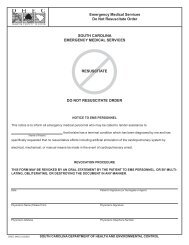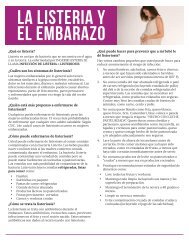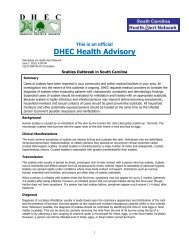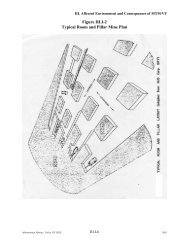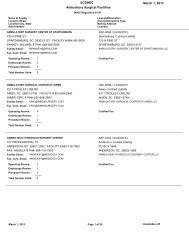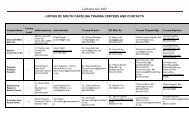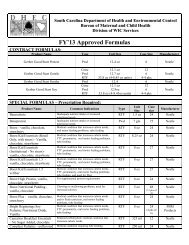RADIOLOGICAL: - Department of Health and Environmental Control
RADIOLOGICAL: - Department of Health and Environmental Control
RADIOLOGICAL: - Department of Health and Environmental Control
You also want an ePaper? Increase the reach of your titles
YUMPU automatically turns print PDFs into web optimized ePapers that Google loves.
•<br />
•<br />
•<br />
Personal items like toothbrushes <strong>and</strong> deodorant<br />
Baby items like diapers, formula or baby food<br />
Books, puzzles, cards or games for entertainment.<br />
Shelters will not have everything you need. In most cases, the shelters will provide<br />
only meals, cots <strong>and</strong> blankets.<br />
You don’t need to turn <strong>of</strong>f your refrigerator or freezer. You should turn <strong>of</strong>f all other<br />
appliances <strong>and</strong> lights before locking your home when you leave.<br />
Check on neighbors to make sure they know about the emergency <strong>and</strong> <strong>of</strong>fer to help<br />
people with disabilities or other special needs.<br />
Take only one car to the evacuation site. Close your car windows <strong>and</strong> allow your air<br />
conditioning or heating system to only recirculate the air in your car. If you need a<br />
ride, ask a neighbor. If there are no neighbors who can help you, listen to the radio or<br />
television for instructions. Don’t take shortcuts. For your safety, follow the exact route<br />
you are told to take.<br />
Shelter in place<br />
In a radiological emergency, you might be told to “shelter in place”. This means staying<br />
where you are <strong>and</strong> making yourself as safe as possible until the emergency is over or<br />
you are told to evacuate. If you are told to shelter in place, you should:<br />
•<br />
•<br />
•<br />
•<br />
•<br />
•<br />
Take your children <strong>and</strong> pets indoors right away.<br />
Cover your mouth <strong>and</strong> nose with a damp cloth, if you’re outside. If you might<br />
have been contaminated, remove your outer layer <strong>of</strong> clothing <strong>and</strong> shoes <strong>and</strong><br />
put them in a plastic bag before going inside to avoid bringing radioactive<br />
material into your shelter. Leave clothes <strong>and</strong> shoes outside.<br />
Close all windows in your home.<br />
Turn <strong>of</strong>f heating <strong>and</strong> air conditioning systems.<br />
Close your fireplace <strong>and</strong> any other place air can come in from outside.<br />
Go to the room that you’ve picked ahead <strong>of</strong> time as your shelter room. The safest<br />
place in your home during a radiological emergency is near the middle <strong>of</strong> your<br />
home or in the basement. A large room with a water supply or bathroom <strong>and</strong><br />
a telephone is best. This room should have as few windows as possible. This<br />
is different from sheltering in place for a chemical disaster, when the shelter<br />
should be high in the home.




